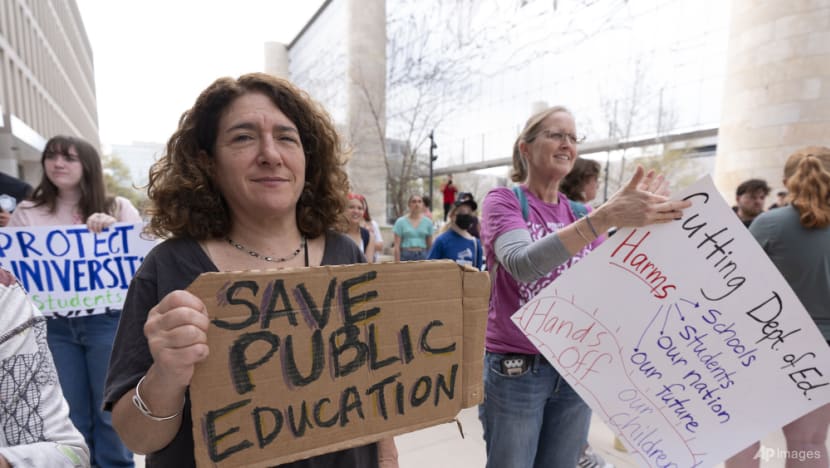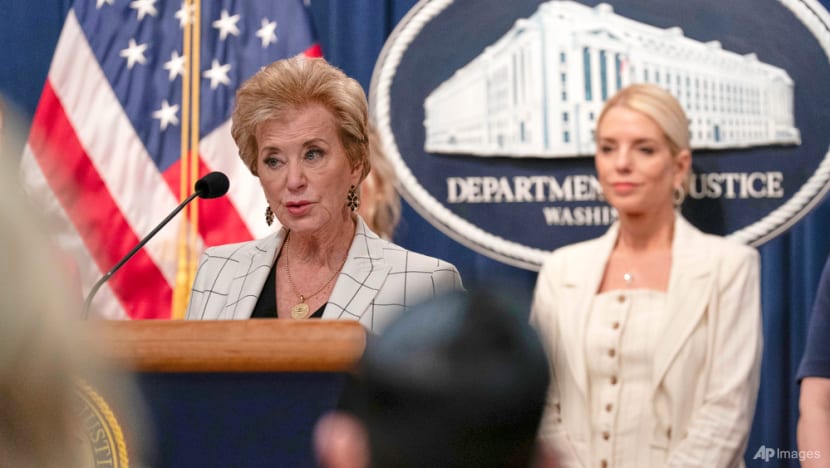US Supreme Court clears way for Trump to slash Education Department

Amy Zeno, left, joins the Hands Off Our Schools rally outside the Department of Education building, Friday, April 4, 2025, in Washington. (Photo: AP/Manuel Balce Ceneta)
The US Supreme Court on Monday (Jul 14) cleared the way for President Donald Trump's administration to proceed with plans to dismantle the Department of Education, part of his broader push to reduce the federal government’s role in education and return authority to the states.
The court lifted a federal judge's order that had reinstated nearly 1,400 workers affected by mass layoffs and blocked the administration from transferring the department’s key responsibilities to other agencies. The legal battle remains ongoing in lower courts.
The justices issued a brief, unsigned order, with the court’s three liberal members dissenting.
Democracy Forward, a liberal legal group representing school districts and unions, said the decision “dealt a devastating blow to this nation’s promise of public education for all children.” Its president and CEO, Skye Perryman, said: “We will aggressively pursue every legal option as this case proceeds to ensure that all children in this country have access to the public education they deserve.”
BACKGROUND TO THE CASE
A coalition of 21 Democratic attorneys general, school districts, and unions filed legal challenges to Trump’s efforts, warning that the dismantling would impair the department’s ability to fulfill its core duties.
The Department of Education, established by Congress in 1979, manages college loans, monitors student achievement, and enforces civil rights in schools. It also distributes federal funding to support students with disabilities and underfunded districts.
While federal law prohibits the department from controlling curricula, staffing or instructional methods, critics argue its federal presence is unnecessary. Republican leaders have long framed the department as a symbol of bureaucratic excess.
PUSH TO CLOSE THE DEPARTMENT
In March, Trump signed an executive order to close the department to the “maximum extent” legally allowed. He stated: “We’re going to be returning education, very simply, back to the states where it belongs.”
Trump promised to maintain certain key programmes, including Pell grants and support for disadvantaged students and those with special needs. He said those services would be transferred to other agencies, such as the Small Business Administration and the Department of Health and Human Services.
The March directive also ordered the transfer of the department’s US$1.6 trillion student loan portfolio to the Small Business Administration and special education services to the Department of Health and Human Services.
Education Secretary Linda McMahon announced plans to cut the department’s workforce in half, part of a broader downsizing strategy that avoids requiring congressional approval to formally eliminate the agency.
McMahon on Monday hailed the court’s action as a “significant win for students and families,” writing in a social media post: “The US Department of Education will now deliver on its mandate to restore excellence in American education.”

COURT BATTLE
In May, US District Judge Myong Joun, a Biden appointee, ruled that the firings could “likely cripple the department.” He ordered reinstatement of the affected workers and halted the transfer of programs.
“The plaintiffs are likely to succeed in showing that defendants are effectively disabling the department from carrying out its statutory duties by firing half of its staff, transferring key programs out of the department, and eliminating entire offices and programs,” Joun wrote.
The Boston-based 1st US Circuit Court of Appeals upheld Joun’s injunction in June, rejecting a Trump administration request to pause it.
In its Supreme Court appeal, the Justice Department accused Joun of judicial overreach.
In her dissent, Justice Sonia Sotomayor wrote that the court’s decision handed the president “the power to repeal statutes by firing all those necessary to carry them out.” She warned that lifting the injunction “will unleash untold harm, delaying or denying educational opportunities and leaving students to suffer from discrimination, sexual assault, and other civil rights violations without the federal resources Congress intended.”
IMPACT ON EDUCATION
Critics of Trump’s plan argue that the shutdown could delay federal aid to low-income schools and special education programmes, resulting in potential staffing and programme cuts. They also warned of harm to civil rights enforcement, student performance tracking, and college financial aid systems.
Despite these concerns, Monday’s Supreme Court decision allows the Trump administration to resume its efforts to reduce the federal government’s role in education, with key functions likely to be relocated across various agencies.







